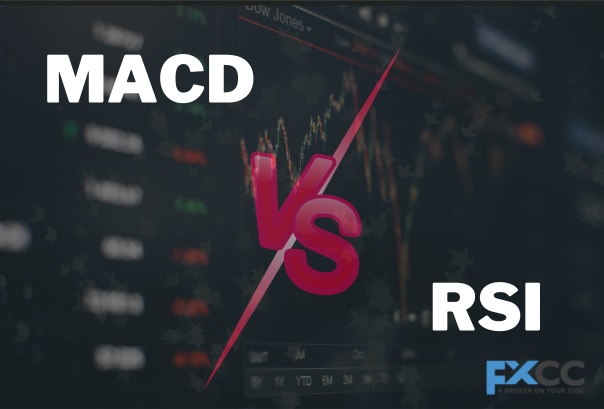In the fast-paced world of technical analysis, where charting patterns and indicators hold the key to unlocking market movements, two titans stand out: the Moving Average Convergence Divergence (MACD) and the Relative Strength Index (RSI). Both have earned their reputation as powerful tools for gauging momentum, identifying trends, and spotting potential buying and selling opportunities. But for traders seeking the ultimate edge, a crucial question arises: MACD vs. RSI – which reigns supreme?

MACD: Decoding the Dance of Moving Averages
The MACD resembles a captivating dance between two exponential moving averages (EMAs). The MACD line itself represents the difference between a fast-moving EMA (typically 12 periods) and a slow-moving EMA (usually 26 periods). A signal line, often a 9-period EMA of the MACD line, further clarifies the trend direction. This dynamic interplay between the lines offers valuable insights:
- Crossovers: When the MACD line crosses above the signal line, it traditionally signals a bullish trend, suggesting that the price momentum is picking up. Conversely, a crossover below the signal line indicates a bearish trend, hinting at a potential decline in prices.
- Divergence: When the price movement diverges from the MACD indicator, it can be a sign of an impending trend reversal. For instance, if the price keeps making new highs but the MACD fails to follow suit, it might suggest a weakening uptrend and a possible reversal.
- Histogram: The difference between the MACD line and the signal line is displayed visually as a histogram. Expanding bars on the histogram often indicate rising momentum, while contracting bars suggest waning momentum.
RSI: Unveiling the Secrets of Relative Strength
The RSI, on the other hand, takes a different approach. It focuses on the magnitude of recent price movements to determine whether an asset is overbought (potentially due to be sold) or oversold (potentially due for a price increase). The RSI oscillates between 0 and 100, with readings above 70 generally considered overbought and readings below 30 considered oversold.
- Overbought and Oversold Zones: When the RSI ventures into the overbought zone, it suggests that the asset might be due for a correction as buyers become scarce. Conversely, readings in the oversold zone might indicate an oversold condition, potentially attracting value buyers back into the market.
- Centerline Crossovers: Similar to the MACD, the RSI can also generate signals through centerline (50) crossovers. A move above the 50 line suggests bullish momentum, while a drop below it indicates bearish momentum.
- Momentum Slopes: The slope of the RSI line itself can also be informative. A steep upward slope suggests strong buying pressure, while a steep downward slope indicates strong selling pressure.
The Champion’s Belt: Weighing the Pros and Cons
So, which indicator takes home the champion’s belt? The truth is, there’s no single victor in the MACD vs. RSI battle. Both indicators have their strengths and weaknesses, and the optimal choice depends on your specific trading style and market conditions.

MACD’s Advantages:
- Trend Following: The MACD excels at identifying trends, particularly through crossovers and divergences. This makes it a valuable tool for trend-following traders who capitalize on sustained price movements.
- Momentum Gauge: The MACD’s histogram effectively portrays the strength of the current trend, allowing traders to assess the intensity of buying or selling pressure.
MACD’s Disadvantages:
- Lagging Indicator: As the MACD relies on moving averages, it can sometimes lag behind price movements, particularly in volatile markets. This can lead to delayed signals and missed opportunities.
- Noise in Ranging Markets: In sideways markets where prices fluctuate within a range, the MACD can generate choppy signals, making it challenging to interpret.
RSI’s Advantages:
- Overbought/Oversold Signals: The RSI’s core strength lies in its ability to identify overbought and oversold conditions, which can be helpful for swing traders and short-term investors.
- Versatility: The RSI can be applied to various asset classes, including stocks, forex, and even commodities. Its adaptability makes it a valuable tool across different markets.
RSI’s Disadvantages:
- False Signals: The RSI can generate false signals, especially in highly volatile markets or during strong trends. This can lead traders to make impulsive decisions based on misleading indicators.
- Limited Trend Following: While the RSI can provide some insight into momentum, it’s not as adept at identifying trends compared to the MACD.
In Conclusion In conclusion, forget about picking a winner between MACD and RSI. The true advantage comes from using them together. They act like a complementary detective team – the MACD tracks the trend’s direction, while the RSI gauges if the market is stretched thin. By combining their insights, you can confirm signals, avoid false leads, and identify high-probability opportunities to buy or sell within a trend. Remember, these indicators are there to empower your decisions, not guarantee them, so use them wisely to gain a sharper edge in your trading endeavors.


